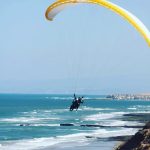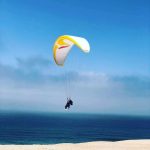A beginner’s guide to paragliding equipment
Paragliding is an exhilarating and adventurous activity that involves gliding through the air using a fabric wing and the natural elements of wind and thermals. However, before taking to the skies, it is essential to understand the different types of paragliding equipment that are required to ensure safety and enjoyment during the flight. This beginner’s guide to paragliding equipment will help you learn about the various gear and accessories that you will need to start paragliding.
- Paraglider
The paraglider is the most crucial piece of equipment for paragliding. It is a fabric wing that is inflated with air and provides lift for the pilot to glide through the air. Paragliders come in various sizes, shapes, and designs, and the choice of a paraglider depends on the pilot’s experience level, weight, and flying goals. Beginners should opt for a wing with a lower aspect ratio and higher stability to ensure ease of handling and safety.
- Harness
The harness is another essential piece of paragliding equipment that connects the pilot to the paraglider. It is a comfortable and adjustable seat that includes straps and buckles to secure the pilot during the flight. The harness also contains a reserve parachute, which is a crucial safety feature that is used in emergencies such as equipment failure or unexpected weather conditions.
- Helmet
A helmet is an essential accessory for paragliding as it protects the pilot’s head from impact and injury in case of a crash. A good paragliding helmet should be comfortable, lightweight, and have adequate ventilation. It should also have a chinstrap and a visor to protect the pilot’s face and eyes from the sun, wind, and insects.
- Variometer
A variometer is a device that provides information about the vertical speed and altitude of the paraglider. It helps the pilot to maintain the right altitude, detect thermal currents, and navigate through the air. Variometers come in various types, including digital, analog, and GPS-based, and the choice of a variometer depends on the pilot’s preferences and budget.
- Reserve parachute
A reserve parachute is a crucial safety feature that is used in case of emergencies such as equipment failure, pilot error, or unexpected weather conditions. It is a small, lightweight parachute that is deployed manually or automatically in case of a parachute or equipment failure. The reserve parachute is attached to the harness, and it is essential to ensure that it is properly packed, maintained, and inspected regularly.
- Radio communication system
A radio communication system is a device that enables the pilot to communicate with other pilots or the ground crew during the flight. It is a useful tool for navigation, safety, and coordination, and it can be either handheld or installed in the helmet. The radio communication system should be compatible with the pilot’s equipment, have a clear sound, and have a long battery life.
- Windsock
A windsock is a simple but essential accessory for paragliding that helps the pilot to determine the wind direction and speed. It is a tube-shaped cloth that is mounted on a pole and moves in the direction of the wind. The windsock should be visible from the launch site and be positioned in an open area away from obstacles.
In conclusion, paragliding is an exciting and challenging activity that requires proper training, practice, and equipment. This beginner’s guide to paragliding equipment has provided an overview of the essential gear and accessories required for a safe and enjoyable paragliding experience. Remember to choose equipment that suits your experience level, budget, and flying goals, and always prioritize safety over thrill.


